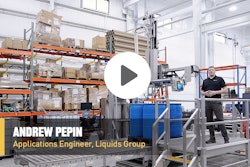
Healthcare Packaging: How do you envision the future role of packaging as it relates to patient adherence/compliance with medication regimens?
Walter Berghahn: Considering our political landscape, healthcare will be front and center for much of the year. Patient adherence will continue to be of interest but I do not anticipate any dramatic shifts. Packaging in general will continue to be important as we roll out DSCSA (Drug Supply Chain Security Act).I hope the industry and government will come to the realization that unit-of-use packaging is the only way to gain full advantage of serialized packaging. If we can take that step then I think the leap to patient adherence is much smaller.
What changes do you see ahead in terms of the role of technology (smartphones, wireless capabilities, etc.) in advancing patient adherence/compliance?
We have already seen some significant adoption of dose reminders through cell phones and e-mail. I think this is a necessary step but it doesn't close the loop. We are no closer to verification of doses taken, which is the only measure of success. We have examples of technology-integrated packaging that goes back more than 10 years to the advent of RFID. Many RFID-enabled packages are used in clinical trial packaging. Bottom line: It works. It can be done and I think it would be successful.The problem: No one wants to pay for it.
For years, there’s been talk of improving patient adherence by switching from traditional vials and caps to blister or wallet-style packs. With some products as exceptions, I’m not sure that’s taking place. What is your viewpoint here?
It's happening in pockets, [but] not on a broad scale. The vial issue is quite simple—this is pharmacists protecting their turf. They are afraid that if there are prepackaged scripts then their reimbursement could be cut.They are probably right. The exceptions you reference are acute care drugs, which can have variance in prescribing. Most chronic care drugs have a consistent dosing regimen and could be packaged in a wallet style without any confusion. I still believe this shift will be driven by the healthcare industry. They are trying many different tools to improve patient adherence but have had limited exposure to better packaging. Those that have seen it and like it have no idea how to integrate it.
What are the latest statistics you are aware of with regard to the financial and loss of life costs due to patient noncompliance?
I haven't seen any updated data on healthcare costs due to nonadherence since the NEHI report from several years ago. Many stakeholders involved in medication adherence quote the $290 to $300 billion of avoidable healthcare costs due to nonadherence. What this doesn’t take into account is the pharmaceutical industry’s revenue loss from nonadherence. A more recent study presented at one of our latest RxAdherence conferences suggests global pharmaceutical revenue loss due to medication nonadherence could top $560 billion. Efforts to improve medication adherence will prove beneficial to all stakeholders, but we mustn’t lose sight of the most important stakeholders, the patient population. A patient-focused, patient-centric supply chain, from manufacturers to caregivers, can improve adherence and outcomes with reduced costs. Per the CapGemini study, “Increasing adherence rates by only 10 percentage points would translate into a $41 billion pharmaceutical revenue opportunity in the U.S. ($124 billion globally), accompanied by improved health outcomes and decreased healthcare spending.”
The financial implications of using blister packs compared to vials and caps has always been a factor that manufacturers consider when evaluating the types of packaging materials and related machinery they’re going to use. How do you see this issue today?
Certainly this discussion always takes place—the cost to replace bottle lines with blister lines.The question I always ask is, “How is it you can afford to pack in blisters for the rest of the world but you cannot afford to do it for the U.S. market?" The U.S. is the only bulk distribution market I am aware of—I am sure there are exceptions but in general blisters are the package of choice for the rest of the world.
Realize that manufacturers don't actually pack vials. They pack 500- and 1,000-count bottles. It's the cheapest thing they can do. The cost of the vial is not theirs, it belongs to the pharmacy. On a straight one-to-one blister-to-bottle comparison, the breakeven point is around 35 tablets. Below 35 the blister is cheaper; above 35 it’s the bottle but a 500-count bottle that is broken into 30-day prescriptions means 17 prescription vials, caps and labels plus the original container.
Now, we should add into "costs," the labor in the pharmacy, the [price] of errors in pharmacy. Repacking is prone to error and there are statistics around that. With supply chain security we have a loss of security when we shift from the bulk container to the vial. So we have a less-expensive container leaving the pharmaceutical manufacturer but at what cost downstream and with what associated risks? The blister shift would likely increase outsourcing but that is happening already. Pharma companies are less inclined to do their own packaging, becoming in many cases focused on developing drugs and less on packaging them. This is even more prevalent with generics suppliers, which make up 85% of the market today.
Another potential limiting factor to the use of blister packs is that patients with physical or mental impairments might have difficulty with using them. Any thoughts on this?
This is absolutely a valid statement. Every package goes through protocol testing, according to U.S. CPSC (Consumer Product Safety Commission) guidelines.It is the guidelines themselves that create part of the problem. They specifically preclude anyone with obvious physical or mental impairments from testing. So, if the seniors you are testing are basically healthy then the packages will pass protocol and seniors with physical impairments will struggle to get into them. Even a normal pharmacy vial can cause difficulty for some withphysical issues. The challenge becomes modifying packages to allow those with physical impairments to gain access while still providing adequate child resistance.
Where do you see the overall patient adherence issue headed in the next three to five years and what other issues should we expect down the road on this topic?
It will continue to be a part of the conversation. I don't expect that the lawmakers are going to suddenly focus on packaging as a solution but we will continue to work with healthcare providers and users to promote the form. There have been plenty of victories and there will be more. There are numerous opportunities for packaging in adherence and supply chain security. Unit-dose packaging by its very nature increases security by eliminating repackaging in pharmacy. If we add adherence features to those packs then it is a stronger tool for the market. All we can do is keep the message in front of the people making decisions.


























